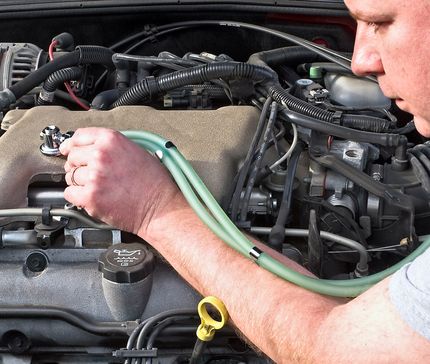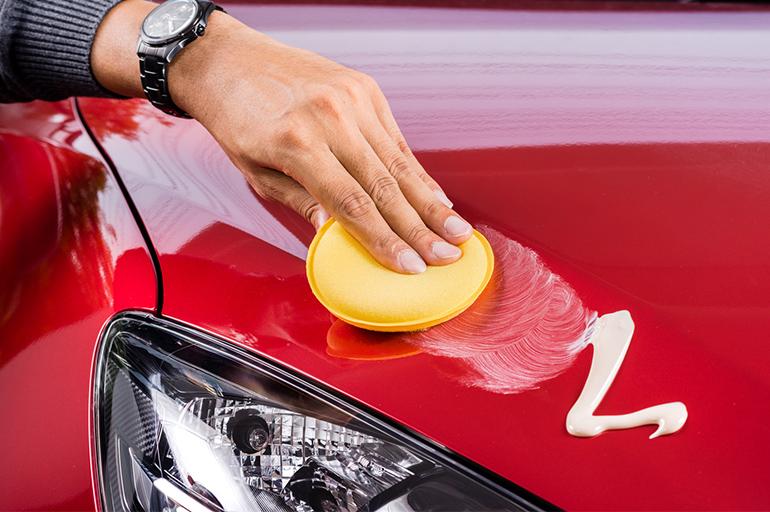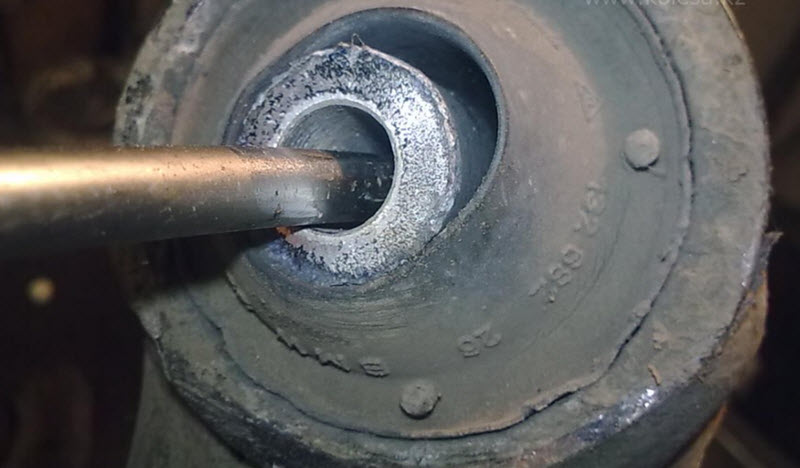
Silent blocks wear
Content
Rubber-metal hinges, which serve to dampen shock and vibrational loads by limiting the mobility of mating parts, are called silent blocks. The first signs of wear on the suspension silent blocks are knocks, squeaks and a decrease in the comfort of movement. Ignoring these symptoms over time can lead to failure of running gear components and poor controllability.
In a car, on average, there are about 10 pairs of rubber-metal joints, in this article we will analyze in detail all the common problems of silent blocks, and also consider ways to solve them.
Signs and causes of wear of silent blocks on a car
Silent blocks cease to perform their function due to the destruction and loss of elasticity of their rubber insert under the influence of vibration, shock loads and aggressive environments or errors when installing a new part. Temperature also affects the service life of silent blocks. In the cold, the rubber "dubs" and is more exposed to destructive influences before warming up.
Worn rear beam bushing on Renault Megane
Complete detachment of the metal bushing of the silent block
In addition to the basic suspension units (arms, struts, beams), silent blocks can also be used in places where a subframe or frame is attached to the body, engine and gearbox suspension points, stretch marks, stabilizers and other parts. You can determine the breakdown of each of them by the characteristic features collected below in the general table.
| Signs of wear of the silent block | Breakdown cause | Why is this happening? |
|---|---|---|
| Steering wheel vibration | Backlash hinges of the front levers. | The wheels acquire an additional degree of freedom, the angles of their installation in motion change, which leads to a deterioration in handling. |
| Yaw limber at speed | ||
| Uneven tire wear | Wear of the silent blocks of the levers of the corresponding axle. | The hinge does not provide the necessary rigidity for attaching the lever to the body or subframe / frame. As a result, the camber becomes excessive or insufficient, the contact patch of the tire with the road changes, the outer or inner side of the tread experiences increased loads. |
| Steering wheel withdrawal | Wear or rupture of the silent block of the front suspension on one side. | A worn or destroyed silent block on one side leads to the fact that the installation angle of the corresponding wheel changes. It acquires an additional degree of freedom, the kinematics of the suspension changes (the running gear works differently from different sides) and the car pulls to the side. |
| Loss of vehicle control when braking | ||
| Steering deterioration | Worn silent blocks of front and rear levers or beams. | Silent blocks that work incorrectly due to defects give the wheels an additional degree of freedom, which is why they try to “move in” or “pass apart” in a turn and the car begins to resist turning. |
| Vertical swing of the front / rear of the car | Wear of the silent blocks of the front / rear shock absorber struts. | When the rubber of worn silent blocks changes their original properties, they begin to work as an elastic element and, under the influence of loads, begin to spring excessively themselves, instead of transferring these loads to the strut springs. |
| Skids and lateral vibrations of the rear of the car | Wear on the silent blocks of the rear beam or levers. | The wheels of the rear axle receive an excessively large freedom of movement relative to the body, because the worn silent blocks are compressed / unclenched much higher than normal under loads. |
| Shocks and jerks when starting the engine and stopping | Deterioration of engine mounts. | Supports cease to dampen shock and vibration loads transmitted to the body. The subframe begins to shift relative to the body by a greater amount than provided by the factory. |
| Increased roll when driving on rough roads and cornering | Wear of silent blocks of stabilizer struts. | The connection between the suspension elements from different sides is broken. Because of this, the anti-roll bar cannot counteract rolls. |
Some of these symptoms may equally likely indicate malfunctions of different hinges. You can determine which silent block is out of order by a combination of signs:
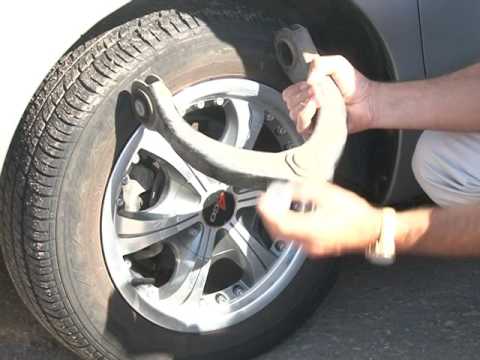
failure of silent blocks, the main reasons: video
- The wear of the silent blocks of the front levers is often accompanied by a loss of directional stability, changes in the camber of the front wheels, the car pulling to the side during acceleration and braking, uneven tire tread wear and steering wheel vibration.
- The wear of the subframe bushings is manifested when driving over bumps, such as speed bumps and undulations in the road surface. while the machine retains controllability, but deaf knocks or creaks are heard in the front. Indirect signs of wear of the silent blocks of the subframe are single jerks when starting and braking, “pecking” of the front end with properly working shock absorbers, a decrease in the gap between the subframe and the spars.
- Signs of wear on the silent blocks of the rear beam appear when overtaking, changing lanes, crosswinds, and also in turns. The rear of the car can be thrown, pulled, extraneous sounds (squeaks, knocks) are heard from behind. If the beam walks a lot, the wheels may touch the plastic fenders of the arches.
- Signs of wear of the rear silent blocks on machines with lever independent suspension, in addition to reducing the stability of the rear axle, are manifested in pronounced knocks when driving through bumps, violation of the wheel alignment angles and uneven wear of the tire tread.
- If there is excessive wear on the silent blocks on the rear pillars, then low-amplitude vibrations of the rear part of the body usually appear, and when bumps are driven, dull tapping is heard from the rear.
- The problems of the silent blocks of the transverse stabilizer and its struts are expressed in an increase in rolls in corners and when changing lanes. The car begins to sway more strongly to the sides when driving on roads with an abundance of bumps.
What happens if you do not change silent blocks for a long time?
Increased roll during cornering indicates wear on the sway bar bushings.
Worn or torn silent blocks do not deprive the car of the ability to move. Therefore, if a breakdown occurs on the way, you can carefully drive to the garage or car service to fix the breakdown. However, long-term operation of a car with faulty rubber-metal joints is highly undesirable, as it leads to more serious breakdowns and affects driving safety.
Firstly, cars with worn silent blocks worse managed, behaves less predictably on the road, which is at least uncomfortable. Secondly, if the rubber does not dampen shock and vibration loads, then other parts associated with the silent block are subject to accelerated wear. Finally, thirdly, with significant wear of the hinge, it is significantly increased risk of accidents due to loss of control.
All the likely consequences of untimely replacement of worn or torn rubber-metal joints are summarized in the table below.
What will happen if you do not change silent blocks: possible consequences
| Worn node | What leads |
|---|---|
| Front arm bushing | Deviation of the vehicle from the trajectory of movement and a decrease in directional stability. |
| Accelerated tire and upper strut wear. | |
| Silent blocks of stabilizer struts | Increased roll and lateral buildup of the body. |
| Risk of a vehicle with a high center of gravity tipping over when making a sharp turn. | |
| Suspension wishbone silent blocks | Accelerated and uneven tire wear. |
| Loss of course stability. | |
| Subframe silent block wear | Jerks and "pecks" when starting and braking. |
| Vibrations and subsidence of the power unit. | |
| Separation of the subframe from the body when it hits the pit. | |
| Grinding of wires, tubes and hoses that run close to the subframe. | |
| Silent block frame on the car | Excessive body roll. |
| Grinding of wires, tubes and hoses that lie near the attachment points of the frame and body. | |
| Partial separation of the frame from the body when getting into an accident or a large hole at speed. | |
| Select DVS or CPP | Jerks when starting and braking. |
| Increased load and accelerated wear of drives (CV joints, axle shafts). | |
| Shaking internal combustion engine and gearbox. | |
| Knocking out gears and wear of shifting mechanisms (on cars with hard linkages backstage). | |
| Deterioration of the rear silent blocks of the racks | Vertical swing of the body. |
| Accelerated wear of the upper pillows (supports) of the racks. | |
| Wear of silent blocks of the rear beam | Loss of course stability. |
| Deterioration of controllability and increased tendency to skid. | |
| Transverse jerks and buildup of the body. | |
| Tires touching fender liner in corners, accelerated tire wear. | |
| incorrect distribution of braking forces on a car without ABS with a "sorcerer". |
When operating a car with failed rubber-metal hinges, the fasteners and the parts themselves in which they are installed wear out, the wheel alignment angles are violated.
For example, on old front-wheel drive VAZs (2108-2115), a worn lower arm silent block can cause the mounting holes of the lugs on the side member to break. After that, it becomes difficult to set the collapse, and even well-tightened bolts weaken faster.
Why do silent blocks creak?
In the early stages, the creak of silent blocks becomes a harbinger of problems, which appears for the following reasons:

How to determine which silent blocks creak: video
- loose fasteners;
- incorrect tightening position (not under load);
- rubber pollution;
- delamination of rubber from metal.
If the creaking arose due to the fact that the silent block bolt was loose and the problem was detected at an early stage, it is highly likely that you can get by with a simple tightening with the torque specified in the auto repair manual. The same applies to silent blocks tightened in an incorrect position (on a relaxed suspension). If the creaking occurred after an unqualified replacement of the rubber-metal joint, it is necessary to loosen the tightening and tighten the nut again on a loaded suspension.
If the silent block creaks after rain, but not in dry weather, dirt may get on the rubber. This is especially true for inserts with slots. This problem is solved by cleaning them and applying lithol, silicone or graphite grease to the surface. But in some cases, a creak in wet weather also appears when the sleeve is torn off, which can be torn off from the rubber part as a result of cranking. In this case, an urgent replacement of the element is required.
How to check the wear of silent blocks with your own hands
The average resource of silent blocks of a car is about 100 thousands kilometers, however, it may be reduced due to the characteristics of operation and the quality of parts. Cheap non-original counterparts can wear out for 50 thousand. In adverse conditions (strong temperature fluctuations, off-road, mud, aggressive driving style), the service life of even quality parts halved. When driven carefully on good roads and in moderate climates, silent blocks can last much longer than average.
If the estimated service life of rubber-metal joints has come to an end or the symptoms described above occur, it is necessary to carry out suspension diagnostics. Inspection and troubleshooting are carried out in the order described below. To do this, it is advisable to put the car in a pit or raise it on a lift, in order to make it convenient to look at the elements of the chassis.
Checking silent blocks for wear: procedure
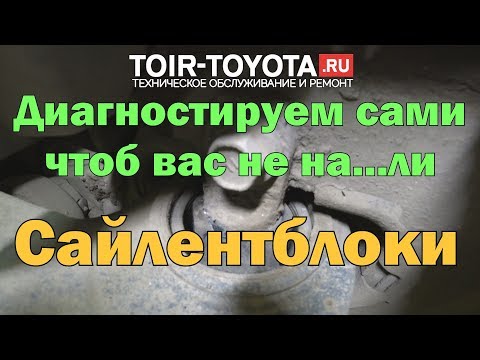
Determination of worn silent blocks on the example of Toyota Camry: video
- Inspection. The first step is to inspect the silent blocks, namely their rubber part. On a serviceable part, there should be no delaminations, tears and deformations (for example, misalignment of bushings). The only correct position of the silent block bushing with a loaded suspension is strictly in the center. If visible defects are found, the part definitely needs to be replaced.
- Check for backlash and free play of levers. After hanging the wheel or lifting the car on a lift, using a mount, create an impact on the lever, pushing it away from the conjugated power element - the frame or subframe. A serviceable hinge is displaced reluctantly and for a short distance, and after the cessation of exposure, it returns to its original position. Significant shifting of the sleeve relative to the center, deformation of the rubber (when the central sleeve almost touches the outer mounting hole), the appearance of a gap between the sleeve and the rubber, cracks that open during compression / expansion indicate wear.
- Checking the levers with loads. If the inspection and manual swing did not reveal visible defects, it is necessary to check the kinematics of the rubber element in operation under a serious load. To do this, you need to rhythmically load the suspension, for example, rocking the car while standing in the correct opening. it is better to do it in the pit, attracting an assistant. so you can immediately notice the destruction of silent blocks, because a gap will appear between the rubber element and the bushing, and large cracks and tears will immediately become visible.When testing the suspension with loads, the central part of the silent block (which is attracted by the bolt) must remain motionless! Normally, only the outer part with a lever, beam or other element moves, and the rubber works for twisting. The course of the central part and its bolt indicates loose fasteners.

Do-it-yourself diagnostics of silent blocks on the example of Niva: video
- Listening. In parallel with the inspection under loads, you need to listen to the sounds. By finding the source of the squeak or knock, a worn or broken rubber-to-metal joint can be quickly identified.
- Checking the stabilizer. After the levers, you can check the stabilizer struts and the stabilizer itself. It is most convenient to do this with two assistants rocking the car to the sides, for example, standing on the thresholds. If the racks (“bones”) have a large stroke, or the anti-roll bar itself “walks” on rubber supports, the rubber-metal hinges of the stabilizer must be changed.
- Checking the rear silent blocks. An easy way to determine the production of silent blocks on the rear pillars is to put the car in a pit and ask an assistant to swing the rear end up and down. At this point, you need to watch how the lower mounts of the racks behave in the eyes of the levers or beams. Defects are evidenced by strong subsidence of the central sleeve, its lagging behind the rubber, cracks and breaks in it that open during the course of the rubber.
- Beam check. On a car with a dependent or semi-independent rear suspension (bridge, beam), you need to hang the rear axle on a jack or lift, and then shake the wheels on both sides in the longitudinal direction. this can be done by hand or by kicking the splint with moderate force. If the wheel moves back and forth a lot, and the silent block shows great freedom of movement, it is faulty.
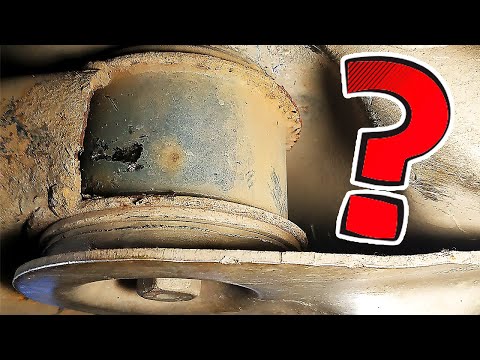
Determination of the state of the silent blocks of the subframe on the Audi: video
Unfortunately, there is no easy way to find out that it is time to change the silent blocks of the subframe or frame. Since they are usually located in hard-to-reach places and are constantly loaded with a body, it is problematic to see defects without partial analysis. On a frame car, you can try to rock the body itself and look from below how much it “walks” relative to the frame.
In the case of a subframe, you should hang out the front of the car, unloading the suspension, and see how much the rubber of the subframe mounts sags. If it is not visible or there are no noticeable defects, partial disassembly may be required for a more detailed inspection.
If it is possible to slightly lower the subframe (for example, on a jack or stop) and release the central bushing of the silent block, you can check it with a metal bar of a suitable diameter. It is inserted into the hole of the central sleeve, after which it is used as a lever for pressure on the rubber in different directions. in this way it is possible to detect cracks, ruptures, and delamination of rubber from iron that are hardly noticeable in other conditions.
Location of silent blocks on the subframe of the Saab 9-5
If defective parts are found, they must be replaced. To do this, in addition to spare parts, you need a tool for dismantling old elements and pressing in new ones. Since the silent blocks sit with a large interference fit, a press and mandrels are required, with which old elements are squeezed out and new elements are installed. so you can change the silent blocks on compact removable parts, like levers.
To replace rubber-to-metal joints on large-sized elements, such as a beam or subframe, special pullers must be used. They consist of a pair of screw-nuts, tubular mandrels and washers of different diameters, with which old silent blocks are squeezed out and new silent blocks are inserted. For better glide, it is advisable to pre-lubricate the rubber bands and mounting holes with soap.
In some cases, self-replacement of silent blocks is very difficult or impossible. This happens, for example, with stabilizer struts, aluminum levers, engine and gearbox mounts. In such a situation, it is better to buy new parts assembled with factory-pressed silent blocks.
Frequent Questions
How to determine that silent blocks are faulty?
You can indirectly determine the breakdown by the appearance of extraneous sounds and a change in the behavior of the suspension during movement, but for accurate diagnosis, you need to inspect the silent blocks and check their work by simulating the operation of the suspension or by acting on the hinges using a mount.
Is it possible to cure bushing wear with grease?
Lubrication eliminates the squeaks of a serviceable, incorrectly installed or slightly worn part, but does not eliminate serious problems. If the rubber has large cracks and tears, a delamination or separation of the metal bushing has occurred, then the use of lubricants is useless - only a replacement will help.
How does a car with worn silent blocks behave?
a car with worn out silent blocks makes extraneous sounds (knocks, squeaks), is worse controlled, loses directional stability. Possible beating and vibration of the steering wheel, yaw, buildup, uneven tire wear, poor steering, jerks when starting and stopping. It all depends on which joints are worn or defective.
